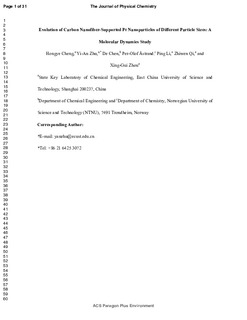| dc.contributor.author | Cheng, Hong-ye | |
| dc.contributor.author | Zhu, Yi-An | |
| dc.contributor.author | Chen, De | |
| dc.contributor.author | Åstrand, Per-Olof | |
| dc.contributor.author | Li, Ping | |
| dc.contributor.author | Qi, Zhiwen | |
| dc.contributor.author | Zhou, Xing-Gui | |
| dc.date.accessioned | 2017-10-27T11:10:13Z | |
| dc.date.available | 2017-10-27T11:10:13Z | |
| dc.date.created | 2014-10-20T19:24:00Z | |
| dc.date.issued | 2014 | |
| dc.identifier.citation | Journal of Physical Chemistry C. 2014, 118 (41), 23711-23722. | nb_NO |
| dc.identifier.issn | 1932-7447 | |
| dc.identifier.uri | http://hdl.handle.net/11250/2462577 | |
| dc.description.abstract | Molecular dynamics simulations employing the ReaxFF reactive force field have been carried out to analyze the structural evolution of fishbone-type carbon nanofiber-supported Pt nanoparticles, with particle size ranging from 5.6 to 30.7 Å. Simulated results indicate that upon adsorption the distribution of first-shell Pt–Pt coordination number and radial distribution function change significantly in Pt nanoparticles up to 2 nm in size and that the restructuring degree of the Pt nanoparticles decreases with particle size, which is attributed both to the reduced binding energy per Pt atom bonded to support and to the increased cohesive energy of the Pt nanoparticles. In the Pt10 particle, the majority of the Pt atoms are detached from the metal particle, leading to atomic adsorption of single Pt atoms on the support. As the Pt particle size is increased to ∼3 nm, however, the crystalline degree of Pt nanoparticles is even higher than that of the corresponding isolated nanoparticles because the strong metal–support interaction has a positive effect on the crystalline degree of the upper part of Pt nanoparticles. Two surface properties of the Pt nanoparticles, namely, Pt dispersion and coordination number of surface Pt atoms, are then computed and found to decrease and increase, respectively, with particle size. Thus, on-purpose control of particle size (and hence the metal–metal and metal–support interactions) is of crucial importance for tuning the superficial structures of supported active metal particles, which eventually determine the adsorption and catalytic properties of catalysts. | nb_NO |
| dc.language.iso | eng | nb_NO |
| dc.publisher | American Chemical Society | nb_NO |
| dc.title | Evolution of Carbon Nanofiber-Supported Pt Nanoparticles of Different Particle Sizes: A Molecular Dynamics Study | nb_NO |
| dc.type | Journal article | nb_NO |
| dc.description.version | submittedVersion | nb_NO |
| dc.source.pagenumber | 23711-23722 | nb_NO |
| dc.source.volume | 118 | nb_NO |
| dc.source.journal | Journal of Physical Chemistry C | nb_NO |
| dc.source.issue | 41 | nb_NO |
| dc.identifier.doi | 10.1021/jp505554w | |
| dc.identifier.cristin | 1165452 | |
| dc.relation.project | Norges forskningsråd: 209337 | nb_NO |
| dc.relation.project | Notur/NorStore: NN4685K | nb_NO |
| dc.description.localcode | This is a submitted manuscript of an article published by American Chemical Society in Journal of Physical Chemistry C, September 23, 2014 | nb_NO |
| cristin.unitcode | 194,66,30,0 | |
| cristin.unitcode | 194,66,25,0 | |
| cristin.unitname | Institutt for kjemisk prosessteknologi | |
| cristin.unitname | Institutt for kjemi | |
| cristin.ispublished | true | |
| cristin.fulltext | preprint | |
| cristin.qualitycode | 1 | |
